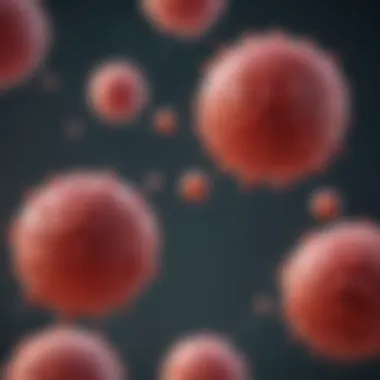The Role of LDL Cholesterol in Human Health


Intro
Low-density lipoprotein (LDL) cholesterol is often viewed as a negative entity, a target in cardiovascular health discussions. However, the role of LDL cholesterol in the human body is not entirely detrimental. This article will dissect its multifaceted functions, the balance it maintains within our biological systems, and its impact on health. Understanding LDL cholesterol transcends beyond mere numbers on a test result; it delves into cellular functions, metabolic processes, and implications for overall health.
Overview of Research Topic
Brief Background and Context
LDL cholesterol is a type of cholesterol that the body produces and derives from dietary sources. Recognized as a cornerstone of lipid metabolism, its primary function includes transporting cholesterol to cells, where it is crucial for processes ranging from membrane synthesis to hormone production. Despite its functions, elevated levels of LDL cholesterol correlate with an increase in cardiovascular diseases, leading to a dichotomous perception.
Importance in Current Scientific Landscape
In recent years, the discourse surrounding LDL cholesterol has shifted. Researchers increasingly emphasize its complexity and the need for a nuanced understanding of its role in human health. Increasing evidence indicates that not all LDL cholesterol is equally harmful, urging clinicians and researchers to reevaluate guidelines for management. This shift is significant for both scientific inquiry and clinical practice, as it may influence patient care strategies and prevention programs.
Methodology
Research Design and Approach
This article draws upon a comprehensive literature review, assessing peer-reviewed articles, clinical trials, and current guidelines from important health organizations. The integration of diverse studies offers a rounded perspective on the significance of LDL cholesterol.
Data Collection Techniques
Data was compiled from various sources, including findings available on platforms like Wikipedia, Britannica, and relevant discussion forums such as Reddit. Emphasis was placed on studies that analyzed the relationship between LDL cholesterol levels and health outcomes, shedding light on the evolving definitions and classifications of this vital lipid.
As ongoing research continues to unveil the intricacies of LDL cholesterol and its physiological roles, practitioners must stay informed about the latest findings to provide optimal care for patients.
Understanding Cholesterol
Cholesterol is a substance that plays a vital role in the human body, serving multiple functions essential for our health. Understanding cholesterol is crucial for grasping how it affects various aspects of physiological processes. It impacts cell membrane structure, hormone production, and vitamin absorption. Moreover, it is intricately linked with conditions like heart disease and metabolic disorders.
In this context, cholesterol becomes not just a simple lipid but rather a critical component influencing health outcomes. Recognizing its significance allows individuals to make more informed lifestyle choices and health decisions.
Definition of Cholesterol
Cholesterol is a waxy, fat-like substance that is found in every cell of the body. It is necessary for the creation of cell membranes, hormones, and vitamin D. The liver produces most of the cholesterol needed, while the rest comes from food sources such as meat and dairy products. Cholesterol travels through the bloodstream in forms called lipoproteins, which include LDL and HDL types.
Types of Cholesterol
Cholesterol
Low-Density Lipoprotein (LDL) cholesterol is often labeled as "bad" cholesterol. Its primary role is to transport cholesterol from the liver to cells throughout the body. However, when present in excess, LDL cholesterol can deposit in blood vessels, forming plaques that narrow arteries and promote cardiovascular disease. Despite this, LDL cholesterol also has its benefits, such as supplying essential cholesterol for cellular functions.
HDL Cholesterol
High-Density Lipoprotein (HDL) cholesterol is known as "good" cholesterol. It serves to remove excess cholesterol from the bloodstream and transport it back to the liver for excretion or reuse. High levels of HDL cholesterol are generally associated with lower risk of heart disease. Its unique feature is its ability to counteract the damaging effects of LDL, thus playing a significant role in maintaining cardiovascular health.
Triglycerides
Triglycerides are another form of fat found in the blood. They store excess energy from food. High levels of triglycerides can contribute to the hardening and narrowing of arteries, similar to LDL cholesterol. However, they serve essential functions, such as providing energy and supporting cellular structures. Keeping triglyceride levels in check is vital for overall metabolic health.
Biological Functions of Cholesterol
Cholesterol is not merely a substance to be feared; it is essential for life. It aids in the formation of cell membranes, which dictate how cells interact with their environment. Cholesterol is also a precursor for manufacturing steroid hormones such as estrogen and testosterone, alongside contributing to the production of bile acids that are crucial for digesting fats.
The multifaceted roles of cholesterol underscore its complexity. While high levels of LDL can lead to negative health effects, cholesterol itself remains a fundamental element for numerous biological processes. Understanding its layers is significant as it helps in recognizing both its beneficial and harmful aspects.
The Role of Cholesterol


The role of low-density lipoprotein (LDL) cholesterol extends beyond traditional views that primarily associate it with cardiovascular risk. Instead, LDL cholesterol is fundamental for numerous biological processes and is a critical factor in maintaining overall health. This section examines its composition, how it transports lipids, and the mechanisms involved in cellular uptake. Understanding these elements is essential as they contribute to both the beneficial aspects and the potential risks associated with LDL cholesterol.
Composition and Functionality
LDL particles are primarily composed of lipids and proteins. The lipid components mainly include cholesterol esters and triglycerides, while apolipoprotein B-100 serves as the primary protein component. This specific protein allows LDL to bind effectively to receptors on various cells. The uniqueness of LDL lies in its ability to carry cholesterol from the liver to peripheral tissues, fulfilling an essential function in lipid metabolism.
Due to its composition, LDL plays a critical role in the distribution of lipids. It participates in the complex process of lipid homeostasis, supporting cellular functions by providing essential nutrients and energy sources.
Transportation of Lipids
LDL cholesterol is pivotal in the transportation of lipids throughout the body. By delivering cholesterol to various tissues, it helps synthesize hormones, vitamin D, and bile acids. This transportation mechanism occurs through different pathways, where cells take up LDL cholesterol via surface receptors known as LDL receptors. When these receptors bind to LDL particles, the particles undergo endocytosis, allowing the cholesterol to enter the cell. Efficient lipid transportation is vital for maintaining cellular health and function.
Cellular Uptake Mechanisms
The cellular uptake of LDL cholesterol is primarily managed through receptor-mediated endocytosis. This process involves the binding of LDL to specific receptors on the cell surface, predominantly the liver and adipoctyes. After binding, the complex is internalized, leading to the release of cholesterol within the cell. This process is finely regulated by the level of cholesterol present within the cell.
When cellular cholesterol levels are low, LDL receptors increase, enhancing the uptake of LDL particles. Conversely, when cholesterol levels are sufficient, the expression of these receptors is diminished. Such regulation is crucial, as dysregulation can lead to elevated cholesterol levels in the bloodstream, potentially resulting in atherogenic conditions.
Proper understanding of LDL cholesterol's role in lipid transport and cellular uptake is essential for recognizing its significance in health and disease management.
In summary, LDL cholesterol serves critical functions in lipid transport and cellular uptake. Recognizing these functions helps to clarify its role in human health and the balancing act needed to manage cholesterol levels effectively.
The Dichotomy of Cholesterol
LDL cholesterol holds a unique position within the discourse on health and wellness. It is often portrayed in a negative light, primarily due to its association with cardiovascular disease. However, this perspective can oversimplify the role of LDL in the human body. Understanding the dichotomy of LDL cholesterol requires a nuanced approach that recognizes both its beneficial roles and the potential pathophysiological effects linked to elevated levels.
Beneficial Aspects of Cholesterol
Despite its bad reputation, LDL cholesterol serves important functions in the body. Within the realm of lipid biology, it is essential to recognize its role beyond merely contributing to artery blockages.
- Cellular Nutrition: LDL cholesterol is crucial for delivering cholesterol to various tissues. This fat is not just for energy but also vital for building cell membranes.
- Hormonal Production: Cholesterol is a precursor to various hormones, including steroid hormones such as cortisol and sex hormones like estrogen and testosterone. Adequate LDL levels ensure that there is enough cholesterol available for hormone synthesis.
- Vitamin D Synthesis: LDL cholesterol indirectly supports the production of vitamin D, especially through sunlight exposure, which is essential for bone health and immune function.
- Brain Function: Cholesterol plays a role in the central nervous system, as it contributes to the formation of myelin. Myelin is critical for the proper conduction of nerve impulses.
"Understanding LDL cholesterol's functional roles can help dispel myths surrounding its danger, revealing its necessity for human health."
While LDL cholesterol is often labeled as harmful, this classification fails to capture its essential roles necessary for maintaining physiological processes.
Pathophysiological Effects of High Levels
High levels of LDL cholesterol can have significant pathophysiological implications. Elevated LDL is a well-documented risk factor for cardiovascular diseases. This is where the sinister side of LDL cholesterol becomes apparent.
- Atherosclerosis Development: When there is an excess of LDL in the bloodstream, it can penetrate the arterial walls. This leads to a process called atherosclerosis, where fatty deposits accumulate, narrowing the arteries and impeding blood flow.
- Inflammation: High LDL levels often correlate with increased inflammatory responses in the body. This chronic inflammation can contribute to heart disease and other related conditions.
- Oxidative Stress: Elevated LDL is susceptible to oxidation, which generates reactive oxygen species. These free radicals can damage cells and tissues, further accelerating cardiovascular disease processes.
- Coronary Heart Disease: There is strong evidence linking high LDL cholesterol levels to coronary heart disease, primarily through mechanisms involving plaque formation and arterial blockage.
In summary, the dual nature of LDL cholesterol is pivotal in understanding its role in human health. It is essential to navigate between recognizing LDL's beneficial aspects while acknowledging the risks posed by high levels. Further research is warranted to develop targeted strategies for managing LDL cholesterol without losing sight of its significance to bodily functions.
Cholesterol and Cardiovascular Health
LDL cholesterol plays a significant role in cardiovascular health, compelling researchers and medical professionals to delve deep into its impact on heart conditions. Understanding the relationship between LDL cholesterol and cardiovascular risk is essential, especially considering the subtle nuances that can influence health outcomes.
High levels of low-density lipoprotein cholesterol are often related to an increased risk of atherosclerosis, which can lead to serious cardiovascular issues. A clear grasp of these mechanisms enhances our ability to manage and prevent heart disease effectively.
Atherosclerosis and Cholesterol
Atherosclerosis involves the accumulation of fatty deposits within arterial walls, contributing to plaque formation. LDL cholesterol is particularly notorious for its role in this process. When LDL particles circulate in excess, they can penetrate the endothelium, the thin layer of cells lining the blood vessels.
Once in the arterial wall, LDL can undergo oxidation, which triggers an inflammatory response. This inflammation recruits immune cells that further exacerbate the buildup, eventually leading to narrowed arteries. In severe instances, this can culminate in heart attacks or strokes.
"A continuous high LDL cholesterol level is a crucial contributor to the development of atherosclerosis, a leading cause of morbidity and mortality worldwide."
Understanding this mechanism allows for better prevention strategies. Regular check-ups and lifestyle modifications can help maintain LDL at optimal levels, potentially reducing the risk of heart disease significantly.


Risk Assessment and Measurement
Effective risk assessment is imperative in managing LDL cholesterol levels. Physicians typically evaluate lipid profiles to determine an individual’s risk of cardiovascular events. Key components of this profile include total cholesterol, LDL, HDL (high-density lipoprotein), and triglycerides.
Standard LDL cholesterol measurements categorize levels as optimal, borderline high, or high. The following guidelines help in the assessment:
- Optimal: Less than 100 mg/dL
- Near Optimal: 100-129 mg/dL
- Borderline High: 130-159 mg/dL
- High: 160-189 mg/dL
- Very High: 190 mg/dL and above
These categorizations aid in deciding the appropriate course of action, including lifestyle changes or medications. Regular monitoring can inform more personalized management strategies, helping mitigate cardiovascular risks associated with LDL cholesterol.
Cholesterol Targets in Clinical Practice
In clinical practice, establishing LDL cholesterol targets is fundamental to cardiovascular risk management. Guidelines have shifted over the years, reflecting new research findings. Current recommendations suggest that patients at high risk for cardiovascular disease should aim for lower LDL cholesterol levels.
For instance, individuals with existing heart disease generally require sustained efforts to reduce their LDL to below 70 mg/dL. Conversely, individuals with fewer risk factors might have less stringent targets.
Clinicians utilize non-pharmacological interventions like dietary modifications and increased physical activity before resorting to medications. If necessary, statins such as Atorvastatin or Rosuvastatin are commonly prescribed to help achieve these targets.
Understanding these targets allows both patients and healthcare providers to engage in informed discussions about reducing cardiovascular risk associated with LDL cholesterol. By effectively managing these levels, the spectrum of potential heart issues can be significantly narrowed.
Controversies in Research
The topic of LDL cholesterol is complex. As research develops, the controversies surrounding LDL continue to gain attention. This is an important part of the article, considering how different viewpoints influence public health recommendations and individual health choices. Understanding these debates can clarify not just LDL’s role in the body, but also what it means for health management strategies.
Debates on Dietary Cholesterol
Recent discussions focus heavily on dietary cholesterol's effects on serum LDL levels. Over the years, the prevailing notion was straightforward: high dietary cholesterol leads to elevated blood cholesterol. However, newer studies challenge this perspective. Some research suggests that for many individuals, dietary cholesterol has minimal impact on serum cholesterol levels. Others argue that this is not true for everyone, highlighting the complexity of lipid metabolism.
Individuals react differently to cholesterol intake due to genetic factors and overall dietary patterns. For instance, some people may maintain stable LDL levels regardless of their diet, while others see a significant increase.
Here are some points to consider in this debate:
- Genetic variance: Some people metabolize lipids differently.
- Dietary context: The overall quality of the diet plays a role. For example, a balanced diet rich in fruits, vegetables, and whole grains may counteract the influence of dietary cholesterol.
- Guidelines: Health organizations have modified their messages. The American Heart Association acknowledges the role of saturated fat more than that of dietary cholesterol alone.
Novel Perspectives on Particle Size and Composition
The dialogue extends beyond just levels of cholesterol in the blood to explore particle size and composition. Some research suggests that small, dense LDL particles are more atherogenic than larger ones. This means they are linked more closely with cardiovascular disease. As a result, focusing on the type of LDL particles rather than just their total amount could provide deeper insights into health risks.
Incorporating these data points might shift treatment norms. When practitioners consider both size and concentration of LDL, this may lead to enhanced strategies for cardiovascular risk assessment.
Key considerations include:
- Particle Size: Small, dense LDL is thought to penetrate arterial walls more easily.
- Composition: The presence of other lipids may influence how harmful these particles can be.
- Testing Methods: The techniques for measuring LDL composition can vary widely, raising questions about standardization in clinical practice.
Given these points, the understanding of LDL is evolving. As new research emerges, it challenges previously held beliefs and complicates the narrative around LDL cholesterol. Recognizing and dissecting these controversies is critical for advancing the conversation on cholesterol's role in health.
Management of Cholesterol
Managing LDL cholesterol is vital for maintaining overall health. High levels of LDL cholesterol can lead to significant health risks, including cardiovascular diseases. Correct management involves lifestyle changes and medical treatments. Understanding these approaches helps individuals take control of their cholesterol levels effectively.
Lifestyle Interventions for Regulation
Dietary Changes
Dietary changes play an important role in managing LDL cholesterol. Consuming a heart-healthy diet can lower LDL levels significantly. Key characteristics of such a diet include high fiber, low saturated fats, and an emphasis on whole foods. Foods rich in omega-3 fatty acids, like salmon and walnuts, are also beneficial.
This dietary approach is both popular and effective for many individuals. One unique feature of dietary changes is the focus on plant-based foods. These foods not only lower cholesterol but also provide essential nutrients. The advantages of this strategy include improved heart health and potential weight loss. However, it requires commitment and can be challenging for people used to a different diet.


Physical Activity
Regular physical activity is another key component in managing LDL cholesterol. Engaging in aerobic exercises—like walking, running, or cycling—can help raise HDL cholesterol while lowering LDL levels. The key characteristic of physical activity is its dual effect: it improves cardiovascular fitness while managing cholesterol.
Physical activity is also a popular choice because it contributes to overall wellness and mental health. Its unique feature lies in the variety of activities available, which can cater to different interests and fitness levels. The advantages include enhanced fitness and a reduction in the risk of other chronic diseases. On the downside, individuals may face challenges like time constraints or lack of motivation to start a routine.
Pharmacological Approaches
Statins
Statins are one of the primary pharmacological approaches for managing high LDL cholesterol levels. They work by inhibiting an enzyme involved in cholesterol production in the liver. The key characteristic of statins is their proven effectiveness in reducing the risk of heart disease. For many patients, they are a beneficial choice due to their widespread use and established guidelines.
A unique feature of statins is their ability to lower LDL cholesterol significantly within weeks of starting treatment. They provide quick results for individuals who need immediate cholesterol management. However, potential disadvantages include side effects, such as muscle pain or digestive issues, which can lead some patients to discontinue use.
Other Medications
Beyond statins, other medications are available for managing LDL cholesterol. These include bile acid sequestrants or PCSK9 inhibitors. The key characteristic of these medications is their different mechanisms of action, providing alternatives for patients who may not tolerate statins well.
These treatments are known to be beneficial for individuals with genetic conditions affecting cholesterol levels. A unique feature of medications like PCSK9 inhibitors is their targeted approach to significantly lower LDL levels. However, they may come with higher costs and varying insurance coverage compared to statins.
The significance of managing LDL cholesterol cannot be overstated. It is a proactive measure that influences long-term health and well-being.
Future Directions in Research
Understanding the future of LDL cholesterol research is essential for students, researchers, educators, and professionals. This field is evolving as new technologies and insights emerge. These advancements may reshape how LDL cholesterol is perceived and managed within the broader context of public health.
Emerging Technologies in Lipidology
In lipidology, technologial advancements open new avenues for understanding LDL cholesterol's role in health and disease. Techniques like high-resolution nuclear magnetic resonance (NMR) spectroscopy enable researchers to analyze lipoprotein particles in detail. These methods provide insight into particle size, density, and composition. This detailed information can help identify specific LDL subclasses, which may correlate with cardiovascular risk.
Additionally, technologies such as next-generation sequencing (NGS) facilitate genetic analysis. NGS allows for a more comprehensive study of genetic variants affecting cholesterol metabolism and LDL levels. This technology could reveal potential biomarkers for assessing cardiovascular health risks, enabling personalized medicine approaches tailored to an individual's genetic background.
Researchers are also exploring artificial intelligence (AI) and machine learning. These tools can analyze enormous datasets from lipid profiles, lifestyle factors, and genetic information. AI can identify patterns and associations that may not be immediately apparent through traditional methods. This capacity to analyze complex variables could lead to groundbreaking insights into LDL cholesterol's impact on human health.
The Role of Genetics in Cholesterol Levels
Genetics play a substantial role in determining LDL cholesterol levels in the body. Variations in genes involved in cholesterol metabolism, such as the LDL receptor gene, can influence how LDL is cleared from the bloodstream. Individuals with genetic polymorphisms affecting these genes may have a heightened risk of elevated LDL levels and associated cardiovascular diseases.
Recent studies have focused on single nucleotide polymorphisms (SNPs) and their connections to LDL levels. By identifying these SNPs, researchers can better understand the heritability of cholesterol levels. This insight aids in recognizing individuals at higher risk even before symptoms manifest.
Furthermore, gene-editing technologies like CRISPR have sparked interest in potential therapeutic strategies. Researchers are investigating ways to modify genes implicated in cholesterol metabolism. Such approaches may lead to innovative interventions aimed at modulating LDL cholesterol levels effectively.
Understanding genetic factors is critical for developing personalized interventions. This may lead to more effective treatments tailored to individual needs.
Culmination
In understanding the role of LDL cholesterol, it is essential to recognize its dual nature. This conclusion encapsulates the importance of LDL cholesterol's functions in the body while acknowledging its potential risks. The balance between maintaining adequate cholesterol levels for health and preventing excessive accumulation is crucial. Therefore, one must consider not only the biochemical aspects of LDL cholesterol but also its broader implications for health management and disease prevention.
Summary of Cholesterol's Role
LDL cholesterol serves multiple functions vital to human health. It primarily transports cholesterol and lipids to cells, which are necessary for membrane synthesis, hormone production, and vitamin D synthesis. However, its significance extends beyond mere transportation.
- LDL is involved in cellular signaling processes.
- It plays a crucial role in maintaining the structure and integrity of cell membranes.
- An appropriate balance of LDL can contribute to overall well-being by supporting metabolic functions.
Conversely, elevated levels of LDL cholesterol are associated with an increased risk of cardiovascular diseases, especially atherosclerosis. Thus, understanding LDL's role is not only about recognizing its benefits but also about managing its levels appropriately to avoid health complications.
Implications for Future Research and Practice
The exploration of LDL cholesterol opens avenues for future research and clinical practice. As science progresses, several significant implications emerge:
- Personalized Medicine: Research may lead to individualized treatment strategies based on genetic predispositions to lipid metabolism.
- Innovative Therapeutics: Developments in pharmacology could yield more effective interventions for managing LDL levels, minimizing cardiovascular risk without adverse side effects.
- Monitoring and Assessment: Advances in technology may refine LDL measurement techniques, making it easier to determine optimal levels in diverse populations.
- Dietary and Lifestyle Interventions: Future studies might deepen the understanding of how specific dietary patterns impact LDL cholesterol and overall vascular health.
"Understanding LDL cholesterol is not just about numbers; it’s about the broader context of health and wellness."
As we delve deeper into these areas, new insights will undoubtedly shape our understanding of LDL cholesterol, emphasizing its complexity and critical importance in human health.



